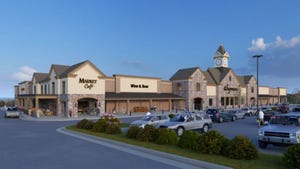Grocery Outlet Sales Soar in Q2
Comps, earnings exceed estimates; leadership eyes managing momentum. The newly public company blows past estimates on comps and earnings as shoppers respond to "wow" offers.

Grocery Outlet’s first quarter as a public company was a very good one.
The Emeryville, Calif.-based extreme discounter, fresh off an initial public offering, posted a 12.2% sales increase and robust 5.8% comp store sales in its fiscal second quarter, which ended June 29.
The results reflected broad-based sales gains across categories, regions and store vintages as shoppers responded to deeply discounted everyday groceries and what the company calls a “wow” experience at stores.
The comp performance—Grocery Outlet’s strongest since the second quarter of 2017—was accompanied by improvements in gross margin, strong performance of new stores and greater financial flexibility enabled by the recent IPO, which helped to lop off some $400 million in debt.
Both sales and adjusted earnings-per-share figures exceeded analyst estimates. The comp figure was well ahead of company guidance which anticipated 3% to 4% comps for the fiscal year.
In a conference call discussing results, CEO Eric Lindberg acknowledged it was a “great quarter” for the business and suggested that the company’s challenge was in managing its considerable momentum.
“With a quarter like that, it’s hard to point at anything that isn’t working. With that said, we have a business that has a lot of complexity, with a lot of moving parts, and I think the most difficult challenge for us as we look forward is what we’ve dealt with for the last five or 10 years: How do you manage the growth responsibly? How do you stay disciplined in the business you’re in?” he said. “There are so many opportunities out there to expand this business, there are so many platforms in retail that one can dive into, I think the challenge for this management team and this model is to stay in your lane, really remain very, very focused on your niche, and not get pulled in a million different directions so that your impact gets diluted.”
Grocery Outlet relies on a unique business model focused on buying excess inventories from a variety of suppliers offered at stores managed by independent operators who sell on consignment and split profits with the company. Lindberg said the model results in motivated operators who can “out-chain the locals and out-local the chains.”
President R.J. Sheedy said the company relies on 1,500 supplier agreements, including longstanding relationships and partnerships with emerging brands resulting in a mix of everyday branded groceries and what the company calls its NOSH (natural, organic, specialty, healthy) assortment offered at discounts of 40% to 70% vs. conventional competitors. The expanded assortment—including recently added selections of fresh seafood and grass-fed beef—is driving frequency, larger baskets and new shoppers to the franchise.
New store growth targeted at 10% annually—or about 30 new units this year—is also contributing to the sales growth. Vice Chairman MacGregor Read said Grocery Outlet sees the potential to add 400 new stores to its 330-unit fleet in existing markets, and another 1,600 stores in adjoining markets. The company primary operates stores on the West Coast but also has a growing contingent in Pennsylvania.
Grocery Outlet expects to spend about two-thirds of its $85 million to $90 million capital expense budget on new stores this year, Read added.
Sheedy said the company entered Pennsylvania a decade ago with the Amelia’s Grocery Outlet acquisition, primarily to realize additional buying opportunities, but is confident in its growth potential in the mid-Atlantic, noting it has taken lessons from a recent expansion into Southern California. The company intends to grow awareness of the brand—buoyed by the successful “Bargain Bliss” campaign—through digital channels and social media, including personalization, Sheedy said. About 1.1 million shoppers subscribe to its “Wow Alert” daily emails, a figure growing at 20% annually.
Sales for the quarter totaled $645.3 million. Gross margin in the quarter was 30.8%, up 30 basis points sequentially from the first quarter and flat with last year’s second quarter results.
About the Author
You May Also Like






